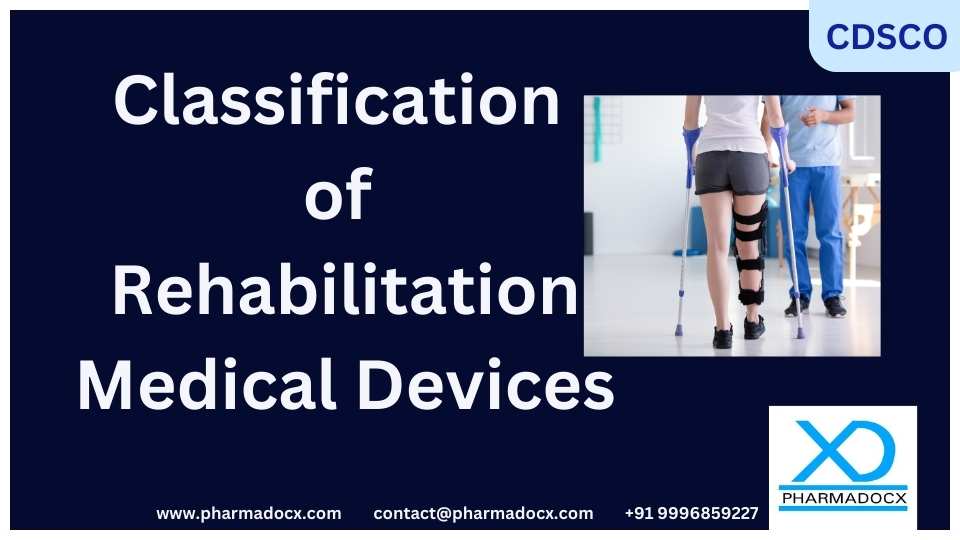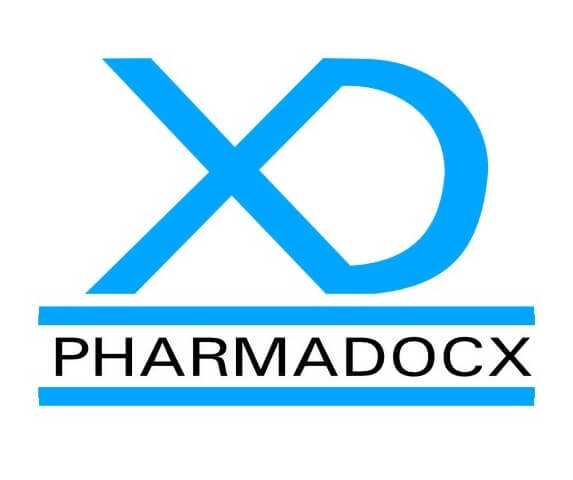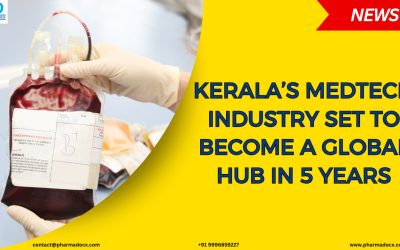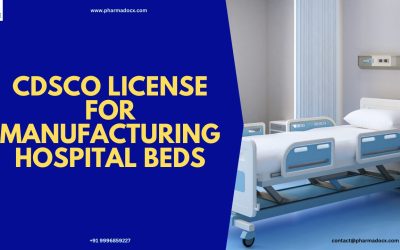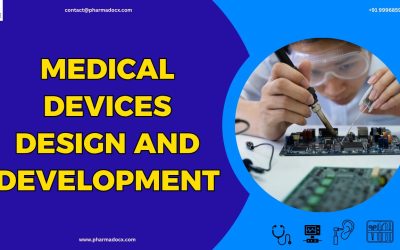The Central Drugs Standard Control Organisation (CDSCO) is the regulatory authority for the medical device industry in India. On 13 September 2021, CDSCO specified 60 Rehabilitation medical devices. This list includes devices such as Exothermic heat therapy packs, Bicycle ergometers, Bed/chair electric massagers, and Acupressure calf bands, all of which fall under the purview of the Medical Device Rules 2017. Now, let’s look at how these devices are grouped.
Table of contents
CDSCO Classification and Regulation of Medical Devices
Medical devices are put into four classes: A, B, C, and D. These groups are based on how the device is used, the risk it might have, and other rules from the Medical Device Rules 2017. If someone wants to get a license to manufacture medical devices, or a license to import medical devices, they need to follow guidelines from the Ministry of Health & Family Welfare. These guidelines can change because of new technology or other updates in medical devices.
A medical device can be many things. It can be a tool, machine, implant, or even software. The main thing is that it’s used for medical purposes.
Types of Medical Devices
In India, medical devices are of two main types: Notified and Non-Notified. In the past, there were no strict rules for selling medical devices. Manufacturers could sell them without following any specific rules. But later, CDSCO made the Indian Medical Device Regulations (IMDR). With these rules, selling medical devices in India became more controlled. Now, only the notified medical devices need to follow CDSCO’s rules.
- Notified Medical Devices: These devices require approval and oversight from CDSCO before they can be sold or used in India.
- Non-Notified Medical Devices: These devices do not need CDSCO’s approval and can be sold without specific regulatory checks.
After 30 September 2022, all Class A & B Medical Devices become notified medical devices & after 30 September 2023, all Class C & D Medical devices will become notified medical devices. (Only applicable for devices that had been earlier classified as non-notified)
Notified Medical Devices Categories by CDSCO
There are 23 categories of Medical Devices notified by CDSCO. These are –
| S.No. | Medical Device Category |
|---|---|
| 1 | Anesthesiology |
| 2 | Cardiovascular |
| 3 | Dental |
| 4 | Dermatological and Plastic surgery |
| 5 | ENT |
| 6 | Gastroenterology |
| 7 | General Hospital/ Orthopaedic instruments |
| 8 | Radiology |
| 9 | Nephrology and Renal Care |
| 10 | Neurological |
| 11 | Obstetrical and Gynecological |
| 12 | Oncology |
| 13 | Ophthalmology |
| 14 | Ophthalmology |
| 15 | Pain Management |
| 16 | Personal Protective Equipment |
| 17 | Physical Support |
| 18 | Radiotherapy |
| 19 | Rehabilitation |
| 20 | Respiratory |
| 21 | Software |
| 22 | Urology |
| 23 | Non-sterile, Non-Powdered, Hand-Held, or Hand manipulated surgical instruments for general use in various surgical procedures |
Classification of Rehabilitation Medical Devices by CDSCO
CDSCO has classified devices in the Rehabilitation category based on their intended use and risk class. There are a total of 60 Rehabilitation medical devices classified by CDSCO. These are –
| S.No. | Device Name | Intended Use | Risk Class |
|---|---|---|---|
| 1 | Acupressure calf band | Intended to wear around the calf to apply pressure to an acupressure point to relieve low back pain, including sciatica and piriformis syndrome. A Non powered belt like device. | A |
| 2 | Arthritis TENS system | Intended to be used as adjunctive therapy in reducing the level of pain and stiffness associated with rheumatoid arthritis or osteoarthritis by electrically stimulating peripheral nerves across the skin (transcutaneous). | B |
| 3 | Back/leg/chest dynamometer, electronic | Powered device intended to assess neuromuscular function by measuring the force or power exerted by the back, chest, and/or leg muscles during flexion. | B |
| 4 | Back/leg/chest dynamometer, mechanical | Non powered device intended to assess neuromuscular function by measuring the force or power exerted by the back, chest, and/or leg muscles during flexion. | A |
| 5 | Balance-training tongue electrical stimulation system | Intended to provide biofeedback for training of balance by sensing body movements and subsequently producing signals which are translated into electrical stimuli applied to the tongue, enabling a patient to correlate electrotactile stimulation with their head and body position during exercise sessions. | B |
| 6 | Bed/chair electric massager | Intended to provide therapeutic massage to the occupant of a bed or chair for the treatment of body aches and pains. | B |
| 7 | Bicycle ergometer | Intended to be used to provide a quantitative measurement of the rate at which work (energy) is performed by a muscle or group of muscles under controlled conditions. | A |
| 8 | Bladder-emptying vibratory stimulator | Intended to initiate urination and facilitate complete bladder emptying through application of small mechanical vibrations to the lower abdomen to promote urethral sphincter relaxation. | B |
| 9 | Blue/red/infrared phototherapy lamp | Intended to emit blue light, red light, and infrared radiation (heating effect) for phototherapy treatment of mild skin disorders (e.g., mild acne), superficial skin wounds, and musculoskeletal symptoms (e.g., pain, spasm, stiffness). | A |
| 10 | Circulating-fluid thermal therapy system | Intended to be used to pump heated and/or cooled fluid (e.g., water) through externally applied packs for localized hot and/or cold therapy to help treat a variety of adverse conditions resulting from musculoskeletal injury (e.g., pain, swelling, inflammation). | B |
| 11 | Cold compression therapy cervical spine collar | Intended to facilitate, through cooling and compression, the treatment of a variety of conditions resulting from injury/surgery to the neck region (e.g., inflammation, stiffness, whiplash). | A |
| 12 | Cold/cool therapy gel | intended for localized topical skin application to provide a cooling effect for underlying muscles/joints to reduce pain and swelling. | A |
| 13 | Cold-air therapy unit | Intended to reduce localized pain/inflammation, and/or to reduce thermal skin damage by applying cold stream of air during dermatological laser treatments. | B |
| 14 | Core-body mechanical weight exerciser | Intended to enable a patient with a lumbar spine injury to perform controlled extension, contraction, and/or twisting movements of the lumbar/thoracic spine back region and the abdomen, for testing and rehabilitation. | A |
| 15 | Deep-tissue electromagnetic stimulation system | Intended to apply an electromagnetic (EM) field to body tissues to: 1) treat musculoskeletal disorders (e.g., osteoarthritis, osteoporosis); 2) treat body pain (musculoskeletal, postsurgical); and/or 3) help facilitate soft and hard tissue wound/injury healing, with no production of a therapeutic deep heat. | B |
| 16 | Electromechanical orthopaedic extracorporeal shock wave therapy system | Intended to provide electromechanical orthopaedic extracorporeal shock wave therapy (OEST) to treat musculoskeletal disorders. | C |
| 17 | Electronic goniometer/kinesiol ogy sensor | Intended to evaluate a patient’s range of motion/movement of individual joints/limbs/spine; it is used in a clinical setting typically before/after a medical/surgical intervention, or to assess degree of physical fitness. | B |
| 18 | Exothermic heat therapy pack | Intended to be applied to the body surface, sometimes with pressure, to provide heat therapy to reduce muscle spasms and cramps and/or for joint and muscle stiffness and pain. | A |
| 19 | Foot sensorimotor therapy mechanical neurostimulator | Intended to provide non-invasive peripheral neurostimulation to the feet for improving somatosensory integration, typically for reducing motor impairments and balance disturbances in patients with neurological or neurodegenerative disorders (e.g., Parkinson’s disease). | C |
| 20 | Gait analysis system | Intended to be used to study walking or running patterns. | A |
| 21 | Hand dynamometer/pinch meter, electronic | Electronic device intended to assess neuromuscular function by measuring the force or power exerted by the muscles of the hand/forearm to squeeze/pinch an object. | B |
| 22 | Hand dynamometer/pinch meter, mechanical | Mechanical device intended to assess neuromuscular function by measuring the force or power exerted by the muscles of the hand/forearm to squeeze/pinch an object. | A |
| 23 | Hydrotherapy treadmill | Powered device intended for use in partially immersed in water, e.g., in a hydrotherapy tank, to provide additional resistance to the treadmill walking exercise without increasing the impact and/or stress on the patient’s joints. | A |
| 24 | Interferential electrical stimulation system | Intended to stimulate peripheral nerves through the transcutaneous application of two currents of slightly different frequencies that cross-over/interfere, producing a beating frequency at the treatment point. | C |
| 25 | Manual goniometer | Non powered device intended to be used in a clinical setting to measure the range of motion of the limb of a patient by measuring the angle of movement achieved at the joint. | A |
| 26 | Medium-wave diathermy treatment system | Intended to produce a therapeutic deep heat within specific volumes of the body through the transcutaneous transmission of electromagnetic (EM) energy in the radio- frequency (RF) bands of 0.5 MHz to 1 MHz | B |
| 27 | Microwave diathermy treatment system | Intended to produce a therapeutic heat 1 to 2 cm below the skin within specific volumes of the body through the transcutaneous transmission of high frequency electromagnetic (EM) energy, typically 2,450 megahertz (MHz) [microwave], to promote tissue healing and pain relief. | B |
| 28 | Musculoskeletal infrared phototherapy unit, | Intended to provide a source of infrared (IR) heat for localized treatment of musculoskeletal pain/injury (e.g., muscle pain, sports injury, rheumatism) and to improve blood circulation in the treated areas to facilitate healing. | B |
| 29 | Musculoskeletal intense therapeutic ultrasound system | Intended to produce and deliver intense therapeutic ultrasound (ITU) waves through the skin to create ablative lesions in subcutaneous soft tissues (e.g., muscles, tendons). | C |
| 30 | Musculoskeletal/ physical therapy laser | Intended to provide noninvasive laser therapy [e.g., infrared phototherapy, low- level laser therapy (LLLT)] for localized treatment of musculoskeletal conditions (e.g., muscle pain, sports injury, disorders of the joints and soft/connective tissues), improving blood circulation in the treated areas to facilitate healing, or for non- needle acupuncture. | C |
| 31 | Parallel bar exerciser, | Intended to assist users in maintaining good walking posture, particularly a person with a disability, a paraplegic, or a patient who has suffered a stroke and is learning to walk. | A |
| 32 | Physical therapy massager | Electrically powered device intended to provide therapeutic massage to a larger area than hand-held massaging devices. | B |
| 33 | Physical therapy paraffin wax bath | Intended to be filled with liquid paraffin wax for physical therapy. | B |
| 34 | Physical therapy steam bath | Intended to apply hot steam as a physical therapy to a patient. | B |
| 35 | Pulsed signal therapy system | Intended to regenerate damaged cartilage, particularly by stimulating the production of collagen types that are present in healthy cartilage. | C |
| 36 | Short-wave diathermy treatment system | Intended to provide a therapeutic deep heat within specific volumes of the body through the transcutaneous transmission of electromagnetic (EM) energy in the radio- frequency (RF) bands of 13 MHz to 27.12 MHz | C |
| 37 | Telemetric diagnostic spirometer | It is a Battery powered portable device Intended to measure several or all respiratory-gas volume and flow parameters needed to evaluate basic pulmonary function [e.g., vital capacity (VC), peak expiratory flow (PEF), forced expiratory volume (FEV), and forced expiratory flow (FEF)], and to transmit the pulmonary function data via a communication device to a healthcare professional(s) at a remote server. | B |
| 38 | Therapeutic nuclear magnetic resonance system | Intended to influence cellular metabolism using nuclear magnetic resonance (NMR) for the treatment of degenerate and pathological changes to the movement/support profiles of a patient’s body, in particular diseased skeletal joints, bones, and surrounding muscle tissue (e.g., cervical and lumbar spine, shoulders, elbows, hands, hips, knees, feet). | C |
| 39 | Silicone Prosthetic Ear | A silicone prosthetic ear which adheres to the skin using safe, biocompatible glue is a reconstructive option for patients born with microtia and other birth differences such as Treacher Collins or Goldenhar syndrome; as well as those who have suffered traumatic injury or undergone cancer resection surgery. | A |
| 40 | Silicone Prosthetic Nose | Silicone prosthetic nose is used to restore normal contour and improve function for patients who have experienced partial or total loss of their nose to traumatic injury, disease or due to surgical removal of the nose (rhinectomy). | A |
| 41 | External asembled lower limb prosthesis | An external assembled lower limb prosthesis is a device that is intended for medical purposes and is a preassembled external artificial limb for the lower extremity. Examples of external assembled lower limb prostheses are the following: | A |
| 42 | External limb prosthesis socket liner | The prosthetic liner acts as an interface that goes between a person’s skin and his or her prosthetic. In short, it’s a barrier – one that is applied to the skin before the prosthesis to protect the wearer’s skin while enhancing comfort and maintaining a more consistent fit. | A |
| 43 | Finger/thumb prosthesis | An artificial substitute for a missing finger or thumb. | A |
| 44 | Upper extremity prosthesis including a simultaneously powered elbow and/or shoulder with greater than two simultaneous powered degrees of freedom and controlled by non- implanted electrical components. | A upper extremity prosthesis including a simultaneously powered elbow and/or shoulder with greater than two simultaneous powered degrees of freedom and controlled by non-implanted electrical components, is a prescription device intended for medical purposes, and is intended to replace a partially or fully amputated or congenitally absent upper extremity. It uses electronic inputs (other than simple, manually controlled electrical components such as switches) to provide greater than two independent and simultaneously powered degrees of freedom and includes a simultaneously powered elbow and/or shoulder. Prosthetic arm components that are intended to be used as a system with other arm components must include all degrees of freedom of the total upper extremity prosthesis system. | B |
| 45 | Powered lower extremity exoskeleton | A powered lower extremity exoskeleton is a prescription device that is composed of an external, powered, motorized orthosis that is placed over a person’s paralyzed or weakened limbs for medical purposes. | B |
| 46 | TruncalOrthosis | A truncalorthosis is a device intended for medical purposes to support or to immobilize fractures, strains, or sprains of the neck or trunk of the body. Examples of | A |
| 47 | Prosthesis External Arm | External prosthesis for upper limb distal to shoulder joint. The device is intended to be used by patients with upper limb loss or deficiency. Prosthesis may include limb components, socket, frame, covering and accessories to enable functional use of the device. | A |
| 48 | Congenital hip dislocation abduction splint | A congenital hip dislocation abduction splint is a device intended for medical purposes to stabilize the hips of a young child with dislocated hips in an abducted position (away from the midline). | A |
| 49 | Denis Brown splint | A Denis Brown splint is a device intended for medical purposes to immobilize the foot. It is used on young children with tibial torsion (excessive rotation of the lower leg) or club foot. | A |
| 50 | Arm sling | An arm sling is a device intended for medical purposes to immobilize the arm, by means of a fabric band suspended from around the neck. | A |
| 51 | Crutches | Crutches helps to transfer load from the legs to the upper body. This is useful for people who cannot use their legs to fully support the weight of their body, due to temporary or permanent disabilities. | A |
| 52 | Power Knee | The Power Knee is a motor-powered microprocessor knee. It provides active assistance while walking on level-ground, climbing and descending ramps or stairs and when standing up. Power Knee enables amputees to maintain and regain mobility and participate in the daily activities. | B |
| 53 | Abdominal Support | It holds abdominal muscles together to relieve pain. Increase circulation at your surgical site to promote healing and decrease swelling. Make physical activity more comfortable. | A |
| 54 | Myoelectric forequarter- amputation prosthesis | The complete control system is to be used exclusively for external prosthetic fitting of the upper limbs. | A |
| 55 | Stocking, medical support | Limb support shaped as a stocking unit that is worn on the upper or lower extremity to support, correct, prevent deformity, or to align body structures for functional improvement. | A |
| 56 | Back Support/Brace | A back brace prevents unnecessary movements that further damage the back. This helps align your spine and strengthen your back muscles. Patients back can heal and back pain will decrease. | A |
| 57 | Prosthetic and orthotic accessory | A prosthetic and orthotic accessory is a device intended for medical purposes to support, protect, or aid in the use of a cast, orthosis (brace), or prosthesis. Examples of prosthetic and orthotic accessories include the following: A pelvic support band and belt, a cast shoe, a cast bandage, a limb cover, a prosthesis alignment device, a postsurgical pylon, a transverse rotator, and a temporary training splint. | A |
| 58 | External limb orthotic component | An external limb orthotic component is a device intended for medical purposes for use in conjunction with an orthosis (brace) to increase the function of the orthosis for a patient’s particular needs. Examples of external limb orthotic components include the following: A brace-setting twister and an external brace stirrup. | A |
| 59 | External limb prosthetic component | An external limb prosthetic component is a device intended for medical purposes that, when put together with other appropriate components, constitutes a total prosthesis. | A |
| 60 | Prosthesis, external, arm, component, hand, external powered, myopotential | A controller for prosthetic terminal devices that enables grip and mode switching using passive RFID tags. | A |
Pharmadocx Consultants provides services for the grant of CDSCO manufacturing and import licenses for Rehabilitation Medical Devices. Contact us today to get started in the world of medical devices!
Call/Whatsapp on +91 9996859227 or write to us at [email protected] for the first free consultation.
Read More –

